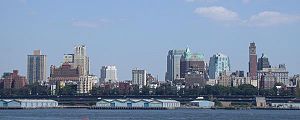 Downtown Brooklyn is the third largest central business district in New York City (following Midtown Manhattan and Lower Manhattan), and is located in the northwestern section of the borough of Brooklyn. The neighborhood is known for its office and residential buildings, such as the Williamsburgh Savings Bank Tower and the MetroTech Center office complex, that give the area its own unique skyline. Since the rezoning of Downtown Brooklyn in 2004, the area is undergoing a transformation, with $9 billion of private investment and $300 million in public improvements underway.
Downtown Brooklyn is the third largest central business district in New York City (following Midtown Manhattan and Lower Manhattan), and is located in the northwestern section of the borough of Brooklyn. The neighborhood is known for its office and residential buildings, such as the Williamsburgh Savings Bank Tower and the MetroTech Center office complex, that give the area its own unique skyline. Since the rezoning of Downtown Brooklyn in 2004, the area is undergoing a transformation, with $9 billion of private investment and $300 million in public improvements underway.
HISTORY
This area was originally inhabited by Lenape Native Americans, until the 1600s. At that time the Dutch arrived, gained control of the land, and called it Breuckelen. Until 1814, Downtown Brooklyn and Brooklyn Heights remained sparsely populated. Robert Fulton’s new steam ferry then began to offer an easy commuting option to and from downtown Manhattan. It made Brooklyn Heights Manhattan’s first suburb, and put Downtown Brooklyn on its way to becoming a commercial center, and the heart of the City of Brooklyn.
The city was home to many prominent Abolitionists at a time when most of New York was indifferent to slavery. Many Brooklyn churches agitated against legalized slavery in the 1850s and 1860s and some acted as safehouses as part of the Underground Railroad movement. Walt Whitman was fired from his job as a reporter at the Brooklyn Eagle due to his support for the Wilmot Proviso when he lived at Willoughby and Myrtle.
The middle 19th century growth of the Port of New York caused shipping to spill over into the City of Brooklyn; many buildings now used for other purposes were built as warehouses and factories. Manufacturing intensified with the building of the Brooklyn and Manhattan Bridges; buildings from that time include the 1915 Sperry Gyroscope Company building, now known as the Howard Building of CUNY. New, extensive infrastructure served the Brooklyn Bridge trolleys.
Following the Second World War, the City Planning Commission, in conjunction with the Borough President’s Office, presented and adopted a Master Plan for the Civic Center, which included an ambitious public improvements program. The program included plans for new buildings for City and State agencies, significant street widening and major housing construction in adjacent areas. A study conducted eight years later highlighted the progress made, emphasizing the widening of Adams Street (and later Boerum Place), which created a long and sweeping approach to Downtown Brooklyn from a modernized Brooklyn Bridge.
By the late 1960’s, the patterns of transition that affected much of urban America initiated concern to protect the borough’s Central Business District from deterioration. In 1969, a comprehensive plan for the entire city was completed and in the report the City Planning Commission stated, “[Downtown Brooklyn’s] economy is vital to the borough and important to the entire metropolitan region.” In re-affirming Downtown Brooklyn’s central role and identifying its problems, the Plan was optimistic that a combination of public and private efforts would stimulate office and commercial construction. A 23-story privately financed office tower at Boerum Place and Livingston Street opened in 1971 and the anticipated growth of the Brooklyn Academy of Music (BAM) succeeded far beyond expectations, giving this cultural institution an important role as a symbolic anchor amid increasing decay during the following decade.
